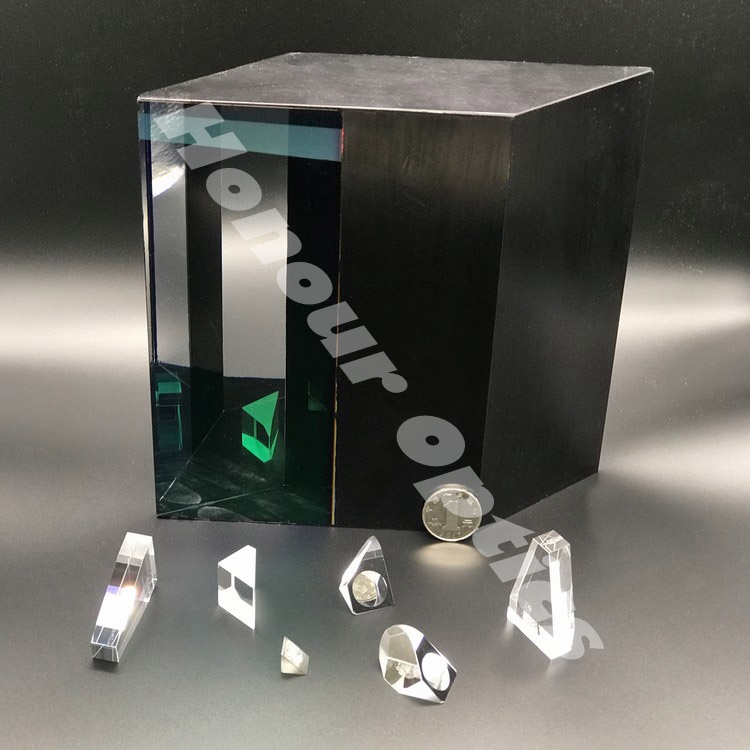
Prisms
Prisms maybe used in an optical system so that the exit beam may be reflected from the entrance direction. The images produced by prisms can be made inverted or rotated.
90 Degree Bending Prisms
90 Degree right angle bending prisms utilize the inherent total internal reflection (TIR) at the hypotenuse to invert the image and achieve a 90° change in direction. Antireflection coatings are applied to the two legs of a standard right angle prism (RAP) to maximize the overall throughput and reduce back-reflections off the interfaces to near zero. Because the internal reflection is independent of wavelength, these prisms can also be used as high energy 90° reflectors for broadband applications where metal mirrors are too absorbing and dielectric mirrors do not reflect a wide enough bandwidth. The Applications include UV beam routing, beam pick off, and variable delay lines as well as broadband, high energy 90° reflectors. High energy AR and BBAR coatings are applied to Legs. Honour Optics also offer other dimensions and wavelengths in prototype and production quantities.

| ||||||||||||||||||||||||
Dove Prisms
Named for its inventor Harting Dove, dove prisms (with antireflection coatings on the ends) completely invert an image by 180 degrees. If the prism is rotated about its axis the image will rotate at twice the rate of rotation of the prism. Dove prisms provide a convenient and precise method of rotating a beam. The long length and square profile makes them easy to mount in a cylindrical sleeve.
Dove prisms need to be used with collimated or near-collimated beams because of the very limited field of view. When used as an image inverting prism the hypotenuse face acts as a TIR surface and is therefore normally not coated. Therefore, it is important to keep this surface clean.
UNIORIENTAL also offers Dove prisms AR coated on the hypotenuse for use in beam-folding applications. As the S1 and S2 sides are used in a total internal reflection (TIR) manner, it is extremely important to keep these two surfaces clean.

| ||||||||||||||||||||
Dispersing Prisms
Dispersing Prisms are used to seperate a beam of white light into its component colors. Generally, the light is first collimated and then dispersed by the prism. A spectrum is then formed at the focal plane of a lens or curved mirror. In laser work, dispersing prisms are used to separate two wavelengths following the same beam path. Typically, the dispersed beams are permitted to travel far enough so the beams separate spatially. A prism exhibits magnification in the plane of dispersion if the entrance and exit angles for a beam differ. This is useful in anamorphic (one-directional) beam expansion or compression, and may be used to correct or create asymmetric beam profiles.

| ||||||||||||||||
Pellin Broca Prism
It is composed by two 30° dispersion prisms and a right angle prism. The mutual Perpendicular surfaces are of the input and output surfaces. When a beam incident in one of the two surfaces(S1&S2)at Brewster angle, then the beam will out-put at Brewster angle too from another surface, and beam is deviated 90degree. It is often used as a dispersion prism.

| ||||||||||||||||||||
Pyramid Prism
Pyramid prism or Corner Cube Retroreflectors have the property that any ray entering will be reflected back to itself, regardless of the entrance angle. |
|
|
| ||||||||||||||||
Wedge Prism
Wedge prism is an optical element with plane-inclined surfaces; usually one face is inclined toward the other at a very small angle. It deflects light toward its thicker portion. It can be used individually to deflect a beam to a special angle. Two wedge prism works together can assembly an anamorphic prism to correct the elliptical shape of laser beam. The wedge prism is ideal for laser beam steering applications. By combining two wedge prisms which can be rotate individually, we can direct the input beam to anywhere within the cone angle θd, whereθd is 4x the specified angular deviation of one wedge. We can make deviation angle from 1deg to 10deg. Other angle can be realized upon request. |
| |||
Specifications | |||
Material | Fused Silica | ||
Dimensional Tolerance | +0.0/-0.1 mm | ||
Wedge Angle Tolerance | ±1arc minute | ||
Flatness | λ/4@632.8nm c | ||
Flatness | λ/10—1λ@632.8nm | ||
Surface Quality | 60-40 scratch and dig | ||
Penta Prism
Specifications | |
Material | BK7 or UV-grade fused silica |
Dimensional Tolerance | ±0.1mm |
90°Deviation Tolerance | < 1 Arc Min |
Surface Quality | 60/40 scratches and dig |
Surface Flatness | λ/4@632.8nm |
Clear Aperture | >85% of diameter |
Coating | Specified by customer |
Roof Prism
Specifications | |
Material | BK7 or UV-grade fused silica |
Dimensional Tolerance | ±0.1mm |
Angle Tolerance | < 3 Arc Min |
Surface Quality | 60/40 scratches and dig |
Surface Flatness | λ/4@632.8nm |
Clear Aperture | >85% of diameter |
Coating | Specified by customer |